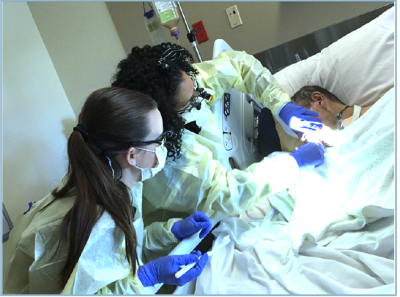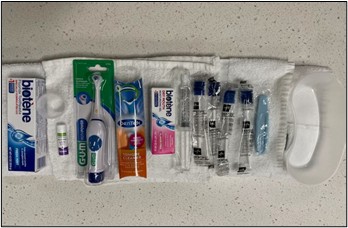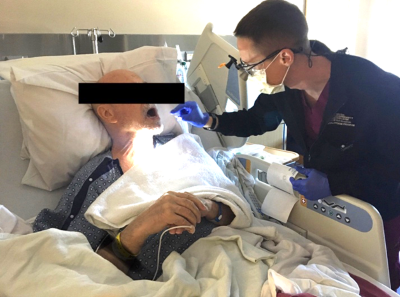Enter your email to receive the CareQuest newsletter:
October 14, 2025

oral care
The scene, sadly, is a familiar one: A patient on a ventilator in a hospital bed is surrounded by beeping monitors and the steady hum of machinery. Medical staff quietly observe and adjust settings to ensure stability and comfort.
“The patient is unable to provide any type of care for themselves,” says Janell Ragains, RDH, a critical care dental hygienist in the ICU Oral Care program that is supported by the Dignity Health Foundation East Valley in Arizona. “They’re totally 100% dependent on us to provide that care for them.”
One type of care that often gets overlooked while the patient is intubated: oral health care. And that can be a serious problem.
“The intubation tube creates a direct pathway where bacteria in the oral cavity can spread from the mouth to the lungs,” Ragains says. “Then that bacteria can cause pneumonia if it goes to the lungs. For patients that are in critical condition, if they get pneumonia, their chance of survival is greatly decreased.”

In 2019, Dignity Health launched a grant-funded pilot program, the ICU Oral Care program, to address oral care for patients in the intensive care unit (ICU) at Dignity Health Chandler Regional Medical Center. Through the program, the organization embedded five critical care dental hygienists into the Medical and Trauma ICUs.
Going strong five years later, the organization received a grant from CareQuest Institute to work toward bringing their ICU Oral Care model to the larger health care system state and nationwide. The funding allows the organization to conduct a study to evaluate changes in patient oral conditions, assess the interprofessional care model, and complete a cost analysis.
Michelle Gross-Panico, the Clinical Program Research and Development Manager and ICU Project Director at Dignity Health, is encouraged by the early results.

“Thus far, we have received positive feedback from families, hospital staff, and physicians,” she says. “I see it as an opportunity to improve integrated care and make a positive impact in the health outcomes for patients in critical condition.”
Moving to a More Integrated Model of Care
A patient on a ventilator can get a dry mouth quickly because their mouth stays open while they are intubated.
“It just creates an environment where bacteria flourishes,” Ragains says.
Nurses can provide some oral health care by keeping the patient’s mouth moist, but dental hygienists are able to assess and identify infections and abnormalities that a nurse typically can’t. The hygienists use the Bedside Oral Exam (BOE) and the Barrow Oral Care Protocol (BOCP) as a guide to provide oral care for those patients.
“Part of our armamentarium is we wear magnification loupes, and they have a light on them,” Ragains says. “So, we can see a lot more than the nurses can with just the naked eye.”
To prevent bacteria buildup, the critical care dental hygienists use lip balm and moisturizing gel to keep the patient’s mouth moist, a small electric toothbrush to clean the teeth, and a tongue scraper to keep the tongue clean. They make sure that patients who need care get it every 12 hours, and they communicate with the patient and the nurses about the patient’s needs.

“A lot of our intubated patients are sedated, but we still talk to them because our understanding is that even though they can't respond, they can still hear us,” Ragains says. “Once we provide the care, we let the family know why we're there and our purpose. We educate them on why oral care is essential for these intubated patients.”
Through the ICU Oral Care program, the dental hygienists also share information with nurses and hospital leaders about the link between oral and overall health.
“It’s just helping educate them on what's going on in the mouth and how it affects the other systems of the body: the heart, the lungs,” Ragains says. “Periodontal disease is also linked to diabetes, which is a disease that our patients are often managing. There are so many factors and reasons why the bacteria in the mouth can cause negative effects to other parts of the body.”
Having a hygienist as part of the care team helps in ways that some might not have foreseen. After a patient is extubated, for example, the hygienists often work with nurses and speech therapists. Ragains recalls a time when a speech therapist told her a patient was having difficulty communicating.
A wall of secretions built up in the back of the patient’s throat was blocking the patient’s airway.
“I was able to let the speech therapist know what I found and reinforce to the therapist and the nurses the importance of keeping the oral cavity moist so that this doesn't reoccur,” Ragains says. “It took a couple days to remove what was there, and then the patient was able to communicate and breathe a little bit better because we opened up the airway.”
Education, Electronic Health Records, and Exploring Payment
Gross-Panico and Ragains say the program has helped patients, hospital leaders, and medical professionals understand the value of having critical care dental hygienists in the hospital. There’s more to learn, though. The organization started patient care and data collection funded by CareQuest Institute in March 2025 and will continue until June 2026.

“We have experienced demand for more training from respiratory therapists,” Gross-Panico says. “And we completed a one-hour continuing education class on the basics of oral health, the link between oral health and overall health, and expanded oral care protocol used by the dental hygienists in the intensive care unit.”
Dignity Health is also exploring opportunities for partnerships with the University of Arizona College of Nursing and the National Network of Healthcare Hygienists to develop curriculum and training opportunities for both student and licensed nurses and dental hygienists.
In the meantime, Gross-Panico says the next step of the ICU Oral Care project is to serve patients in other departments of Chandler Regional Medical Center.
“This will be done by integrating the dental hygienist as a provider type in the electronic medical record, so a consult request can be made for any patient to receive an oral exam and expanded oral care,” she says.
The grant from CareQuest Institute has also allowed Dignity Health to explore a payment model through medical insurance reimbursement.
“I’m deeply grateful for the support from CareQuest Institute to help us blaze new trails,” she adds.